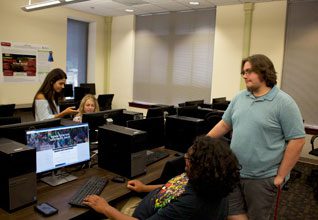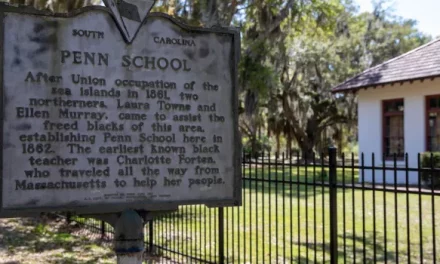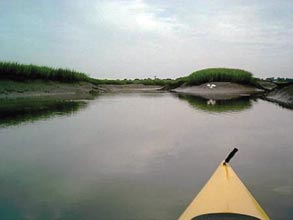 A year of planning, development and plain old hard work by a team of students at the University of South Carolina Beaufort culminated in a fresh, new website for the Penn Center in July. And now the team is already planning to develop a new website for a second client, the Heritage Library Foundation on Hilton Head Island.
A year of planning, development and plain old hard work by a team of students at the University of South Carolina Beaufort culminated in a fresh, new website for the Penn Center in July. And now the team is already planning to develop a new website for a second client, the Heritage Library Foundation on Hilton Head Island.
Â
The Penn Center project began in May of last year when Brian Canada, Ph.D., an assistant professor of Computational Science at USCB, agreed to assist Dr. Rodell Lawrence, executive director of Penn Center, in developing a new website for his organization. Penn Center, on St. Helena Island, is considered one of the country’s most significant African-American historical and cultural institutions. A National Historic Landmark District, it is located midway along the Gullah Geechee Cultural Heritage Corridor, which extends from Wilmington, N.C., to Jacksonville, Fla.
A review of the existing website produced several goals for the new one: Make it fresh and modern with intuitive navigation, driven by a content-management system with integrated e-commerce capability that would enable visitors to find the information they need quickly while allowing prospective donors to select from several levels of financial support. Working closely with Victoria Smalls, director of Development and Marketing, and Mariah Robinson, a former intern at Penn Center, Dr. Canada began researching the 100 most-effective nonprofit websites to find appropriate examples to emulate.
“Then we asked a series of fundamental questions,” he says. “What should the website look like? What kind of content should it have? How should we organize the content? We wanted to make sure we had all of the questions answered before we began doing the development work.”
When classes resumed for the 2015 fall semester, Dr. Canada laid out the project for USCB’s student chapter of the Association for Computing Machinery. ACM is an international professional organization that serves as the student “computer club” on campus. Dr. Canada, the club’s faculty advisor, began by assigning duties. Keila Calderon, a new college freshman at the time, had worked as a web designer with the Disney organization. She became the Project Manager and shared co-webmaster duties with Ashley Fernandez, a junior majoring in Computational Science. Calvin Calvert, a returning adult student who graduated in May, was a former U.S. Army veteran of the war in Iraq. He was assigned responsibility for content management on information pages and adding custom programming code to incorporate website features that were not already built into the content-management system.
Other students were placed in charge of general content and design management, user experience testing and quality assurance. Yet another student, who had previously earned a bachelor’s degree in History and had returned to earn a second degree in Computational Science, served as the resident historian.
The ad hoc leadership and project-development roles enabled the student volunteers to gain useful experience creating a website for a nonprofit organization. They also helped to build student resumes.
After a day-long tour of Penn Center and nearby historical sites on St. Helena Island, the team got down to work. They identified the many types of visitors who accessed the website—historians doing research, descendants of the original Gullah settlers on the barrier island, tourists who wanted to visit, event and conference planners, artists who wanted to exhibit their work in the Penn Center gallery, and people shopping for books about the Gullah Geechee culture, civil rights and the Lowcountry.
Dr. Canada and the students conferred with Ms. Smalls and Ms. Robinson to develop a set of “user stories,” which serve to predict the full range of conceivable questions a web visitor might ask that should be answered with minimal navigation through the website. “In software engineering, user stories can help guide the development of the user interface so visitors know where to click to get the information they want,” Dr. Canada says. When the information was collated into a spreadsheet, Dr. Canada directed his ACM Web team to blend the user stories with the proposed navigation.
Meanwhile, other members of the ACM Web team turned to the visual aspects of the new site. To represent Penn Center’s simultaneous mission of preserving Gullah history while providing cultural and educational services to the St. Helena Island community, the team selected a series of historical photos from the Penn Center archives and a set of recent photos taken by professionals, volunteers and the students themselves.
With the photos selected and the copy edited, it was time to revise the call to action. The Web team worked with Penn Center to devise and implement a simple graduated scale that would enable visitors to select from several named levels of financial support. One final review and the website was done. It launched in July 2016. It can be viewed at www.penncenter.com.
“Penn Center has a much more refreshed web presence now,” Dr. Canada says. “And that’s exactly what they were looking for, along with a tightly integrated donation mechanism with tiered donation levels. The students on the ACM Web team gained project-management and Web-development experience on a high-profile project with real regional, local impact. And the university benefited by re-energizing its relationship with Penn Center.”
Dr. Lawrence at the Penn Center was delighted with the results. “The Wow! Factor, which was my original challenge, was achieved,” he said.
When news of the new website broke, other organizations approached Drs. Canada and Yiming Ji, the Computational Science Program coordinator at USCB, seeking help with their web presence. “The Heritage Library serves as a major resource for researchers interested in the history of Hilton Head Island as well as family ancestry information,” Dr. Canada says. “There’s amazing content on the site, but it needs a more user-friendly content-management system and a team of people to migrate hundreds of pages of content to the new site. Now that the 2016 fall semester is under way at USCB, I want to recruit more students into ACM to work on this. They don’t have to be Computational Science students. This will be our big project for the 2016-17 academic year.”
Since 2002, USCB has tripled its academic degree programs, doubled its FTE enrollment, opened its first on-campus housing (now serving more than 750), joined the NAIA Sun Conference, and fielded conference and national award-winning Sand Shark athletes in nine sports. The university’s two campuses serve a diverse student body of 1,980 students. The Hilton Head Gateway campus in Bluffton, SC, offers cutting-edge Computational Science and Nursing laboratories, and a broad range of academic degree programs. It is home to Sand Shark athletics. The Historic Beaufort campus, located on Beaufort’s downtown waterfront, houses an innovative baccalaureate Studio Art program in close proximity to Beaufort’s many art galleries. Students enjoy opportunities on Hilton Head Island, including the USCB Center for Event Management and a Coastal Ecology research partnership with Vagabond Cruise. USCB serves 1,500 Osher Lifelong Learning Institute (OLLI) members, who participate in more than 1 million course hours annually, placing OLLI at USCB in the top 10 in the country. The University of South Carolina Beaufort offers students an exceptional place to learn and live in an environment focused on growth, preservation and opportunity. For more information, please contact Kerry Jarvis at jarviskc@uscb.edu and 843-208-8030.
Above: From left to right: Keila Calderon, Ashley Fernandez, Jeremy Suarez, and Logan Nichols. All are USCB Computational Science students and members of our ACM club.







